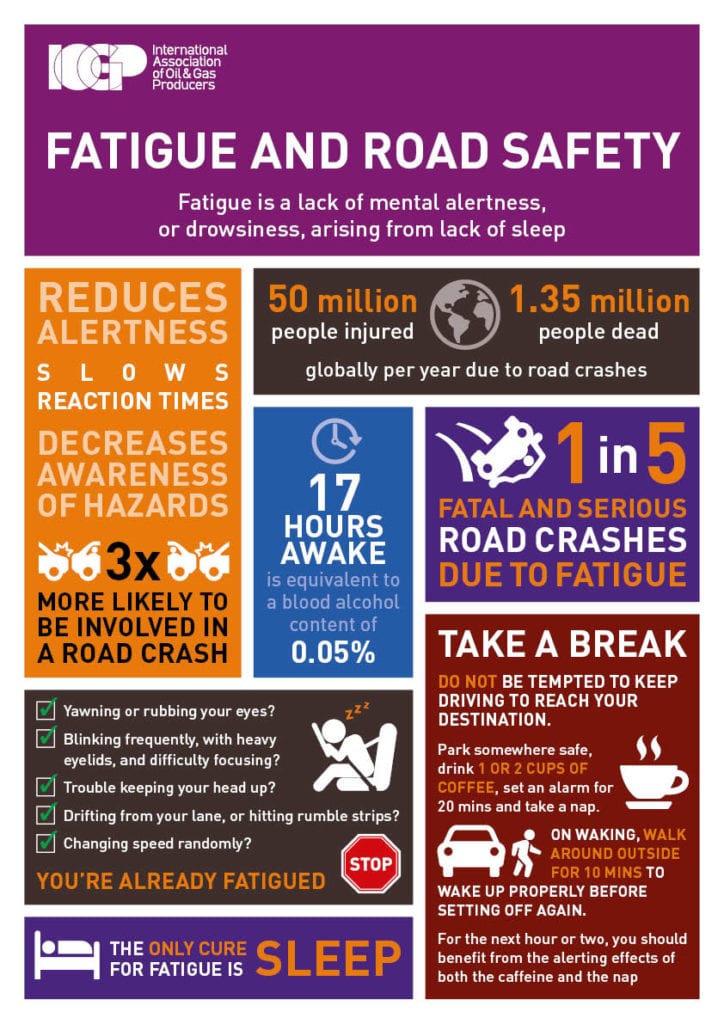
Managing fatigue in the workplace
Given the inherent risks of upstream operations, fatigue is increasingly being recognised as a potential contributor to safety and other incidents.
On this page you’ll find several resources to help you manage fatigue in your workplace, such as guidance to set-up a fatigue risk management system, launch awareness campaigns and links to specialist information.
Managing fatigue - A guide for managers
IOGP Report 626 – Managing fatigue in the workplace is a practical ‘How To’ guide to Fatigue Risk Management and provides an overview of the issues around fatigue with a focus on developing, implementing, and evaluating a Fatigue Risk Management System (FRMS).
It gives managers and other personnel an outline of the fatigue risk issues inherent in oil and gas operations and offers guidance on their assessment and management.

Fatigue awareness materials
A training video, short guide and poster on fatigue and sleep – available in multiple languages, just click to download.
Thse materials have kindly been made available by Shell.


The Dangers of Driver Fatigue
IOGP has launched a driver fatigue campaign to raise awareness of the dangers of driving while tired. All the materials are available for you to use in your own workplace.
- Understand the risks
- Steps to avoid driver fatigue
- Posters, infographics, video
- What companies can do

External resources
Other fatigue guides and references
- Beyond the Midnight Oil external link
- Minerals Council of Australia: Design, Fatigue and Sleep external link
- Digging Deeper external link
- NIOSH external link
- Health and Safety Executive. The development of a fatigue/risk index for shiftworker (2013) s. RR446 external link
- Health and Safety Executive. Human factors: fatigue. Why is fatigue important? 2016 external link
- Worksafe Tasmania, 2015, Fatigue Management. Available from external link
- ACOEM Guidance Statement Fatigue Risk Management in the Workplace ACOEM Presidential Task Force on Fatigue Risk Management JOEM Volume 54, Number 2, February 2012. external link
- Advisory Circular US Department of Transportation Federal Aviation Administration AC No 120-103A Fatigue Risk Management Systems for Aviation Safety. external link
- Circadian White Paper Evolution of Fatigue Risk Management Systems: The “Tipping Point” of employee fatigue mitigation Martin Moore-Ede MD, PhD. external link
- Gertler, J., Popkin, S., Nelson, D., O’Neil, K. Transportation Research Board for the Federal Transit Administration. Toolbox for Transit Operator Fatigue. TCRP Report 81. Washington, DC: National Academies Press; 2002. external link
- Railways and Other Guided Transport Systems (Safety) Regulations. London, UK: Stationery Office; 2006. external link
- Federal Aviation Administration. Advisory Circular: Introduction to Safety Management Systems for Air Operators. AC No: 120-92; 2006. Available at: https://rgl.faa.gov/Regulatory_and_Guidance_Library/rgAdvisoryCircular.nsf/0/6485143d5ec81aae8625719b0055c9e5/$FILE/AC%20120-92.pdf .
- Civil Aviation Safety Authority. Safety Management Systems: Getting Started. Canberra, Australia: Civil Aviation Safety Authority; 2002 external link
- Air Line Pilots Association, International. ALPA White Paper. Fatigue Risk Management Systems: Addressing Fatigue Within a Just Safety Culture. Washington, DC: Air Line Pilots Association, International; 2008. external link
- UK HSSE link Managing Shiftwork HSG 256 ISBN 978 0 7176 6197 8 external link
- Offshore working time in relation to performance, health and safety: A review of current practice and evidence. Prepared by the University of Oxford for the Health and Safety Executive (2010), external link
- SUPREME COURT OF QUEENSLAND CITATION: Kerle v BM Alliance Coal Operations Pty Limited & Ors [2016] QSC 304 external link
More about sleep
- Sleep Foundation external link
- Sleep Health Foundation external link
- Epworth Sleepiness Scale external link
- Karolinska Sleepiness Scale (KSS) external link
- How to succeed? Get more sleep – Arianna Huffington TED Talk You Tube link
- Why do we sleep? – Russell Foster TED Talk You Tube link
- The benefits of a good night’s sleep – Shai Marcu You Tube link
- What if you stopped sleeping – AsapSCIENCE You Tube link
References quoted in infographic
- “Road Traffic Injuries,” December 8, 2018, World Health Organization, go to paper
- “Global Status Report on Road Safety 2018,” World Health Organization, go to paper
- “Wake Up and Drive: Fatigue Causes 20 Percent of Crashes,” June 5, 2013, EHS Today, go to paper
- “Drowsy Driving is even more dangerous than you think,” February 8, 2018, Fortune, go to paper
- “Moderate sleep impairment produces impairments in cognitive and motor performance equivalent to legally prescribed levels of alcohol intoxication,” October 2000, Occupational and Environmental Medicine, go to paper
- “Drowsy Driving: Asleep at the Wheel,” November 7, 2018, Centers for Disease Control and Prevention, go to paper
- “Drowsy Driving is Impaired Driving,” National Safety Council, go to paper
- “CMV Driving Tips – Driver Fatigue,” March 31, 2015, Federal Motor Carrier Safety Administration, go to paper
This fatigue page is a work of the IOGP Land Transportation Subcommittee and the IOGP-IPIECA Health Committee


